There are about 8 million chinstrap penguins, known as Pygoscelis antarcticus, living in Antarctica. They are a key part of the Antarctic ecosystem. These seabirds live in the Southern Ocean, mostly around the Antarctic Peninsula. They are famous for their unique black band under the chin, making them look like they’re wearing a tuxedo.
The chinstrap penguin is a standout among Antarctic wildlife, loved for their cute waddle and expressive eyebrows. These birds can’t fly but have adapted well to Antarctica’s tough climate. They are a symbol of life’s ability to thrive in extreme conditions.
The Charming Chinstrap Penguin: An Introduction
In Antarctica, the chinstrap penguin shines as a true gem. These seabirds, known for their black and white look, win over nature fans and wildlife lovers. Their cute looks and fun behavior make them a favorite symbol of Antarctic wildlife.
Embracing the Adorable Waddle and Jaunty Eyebrows
The chinstrap penguin is loved for their cute waddle. Their happy movements on the ice are a joy to see. Plus, their jaunty eyebrows add to their charm, making them look like tuxedo birds.
Distinguishing Features: The Tuxedo Look and Painted Black Band
The chinstrap penguin stands out with its sleek black and white look, like a tuxedo. The black band under their chin adds to their stylish look. These flightless birds are a symbol of Antarctica, known for their unique features among seabirds.
| Characteristic | Measurement |
|---|---|
| Average Height | 65-75 cm (25-30 inches) |
| Average Weight | 3.5-5 kg (7.5-11 pounds) |
| Maximum Diving Depth | 70 meters (230 feet) |
| Average Swimming Speed | Around 30 kph (18 mph) |
Chinstrap penguins are a beloved symbol of Antarctic wildlife. Their charming looks and behavior enchant everyone who sees these tuxedo birds in the wild.
Chinstrap Penguin: An Underdog Among Antarctic Penguins
The chinstrap penguin (Pygoscelis antarctica) is quite common in Antarctica, with about 8 million birds worldwide. Yet, they are seen as the “underdog” among Antarctic penguins. This is because their numbers are going down, especially around the Antarctica Peninsula. There, they face big challenges from the environment.
Declining Populations Around the Antarctic Peninsula
Over the last 30 years, chinstrap penguin numbers have dropped by 30-50%. Climate change is a big reason for this. It brings warmer temperatures and changes in sea ice. Also, overfishing hurts their food supply, like krill and small fish.
The Largest Chinstrap Penguin Colony on Zavodovski Island
Even with fewer chinstrap penguins, a big colony is found on Zavodovski Island in the South Sandwich Islands. It’s thought to have about 2 million breeding pairs. This makes it a key place for these seabirds and a focus for conservation.
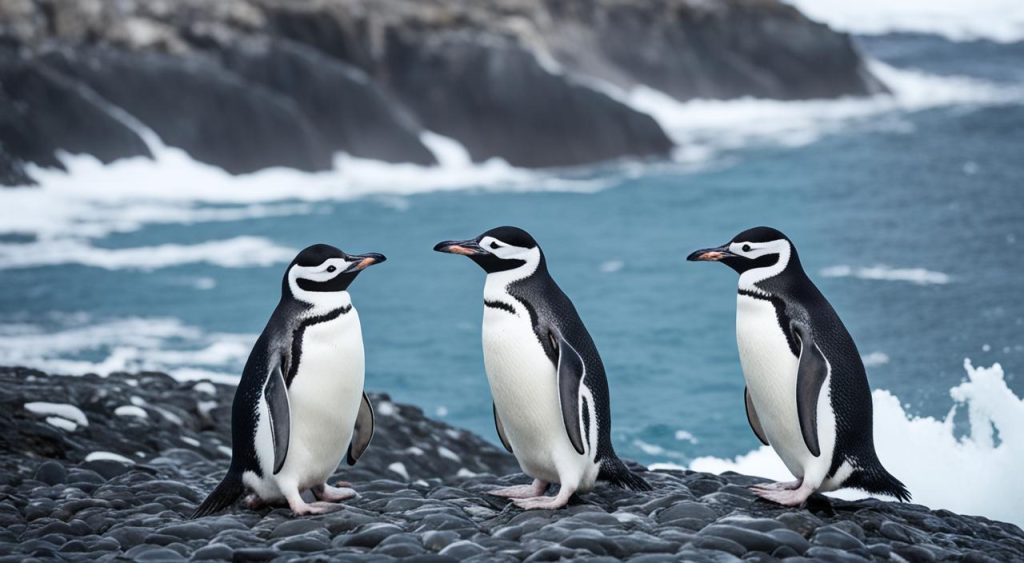
This big colony on Zavodovski Island shows why we must protect chinstrap penguins. They are up against a tough future because of climate change and human actions. These actions affect their homes and food.
Exploring the World’s Largest Chinstrap Penguin Colony
Zavodovski Island, in the South Sandwich Islands, is a remote spot. It’s where the biggest colony of chinstrap penguins lives. This island, about 1,000 miles east of the Antarctic Peninsula, is home to 2 million breeding pairs. It’s a sight to behold for those who get to see it.
To get to this island, you need special Antarctic expedition cruises. These trips let you see the chinstrap penguins up close in their natural setting. Scientists use drones and satellites to count the penguins and learn how to protect them.
A team of six scientists spent three weeks on Zavodovski Island. They studied the chinstrap penguins and the island’s life. They tagged penguins with satellites, looked at their food, and studied the volcanoes. This helps us understand how the penguins live and how the island affects them.
| Key Findings from the Zavodovski Island Expedition |
|---|
| Zavodovski Island is home to more than 1 million breeding chinstrap penguins, the largest penguin colony in the world. Aerial surveys and ground counts were used to survey the penguin colonies and terrestrial biodiversity. Satellite transmitters were attached to chinstrap and macaroni penguins to track their movements and foraging patterns. Penguin guano was collected for DNA analysis to determine their diet and help inform conservation efforts. The 2016 volcanic eruption on the island covered up to half the land in ash, potentially impacting the penguin population. The research aims to establish a robust baseline for monitoring penguin and terrestrial biodiversity on Zavodovski Island and the wider South Sandwich archipelago. |
This expedition to the largest chinstrap penguin colony on Zavodovski Island is crucial. It will help us protect the South Sandwich Islands and the ocean around them. By understanding the penguins and their home, we can work to keep them safe for the future.
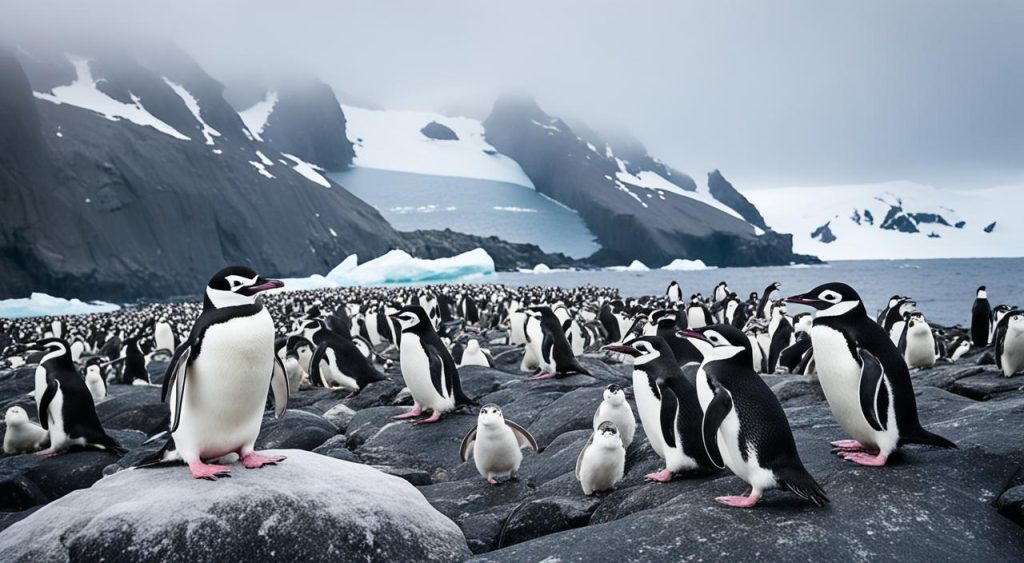
Habitat and Distribution of Chinstrap Penguins
The chinstrap penguin lives in the Southern Ocean, mainly around the Antarctic Peninsula and nearby islands. These birds don’t fly but love the rocky, ice-free spots for their nests and homes. These areas are perfect for their colonies.
Nesting Sites and Breeding Grounds
Chinstrap penguins nest on cliffs, slopes, or flat spots near the sea. This lets them easily get to their food like krill, squid, and fish. They live close to other seabirds, making their homes in lively ecosystems.
The biggest groups of chinstrap penguins are in the Scotia Sea, east of the Antarctic Peninsula. Here, up to 5 million breeding pairs live on the South Sandwich Islands. Other big places for breeding are the South Orkney Islands, the South Shetland Islands, and the west coast of the Antarctic Peninsula.
| Location | Breeding Pairs |
|---|---|
| South Sandwich Islands | Approximately 5,000,000 |
| South Orkney Islands | 927,000 |
| South Shetland Islands | 987,000 |
| West Antarctic Peninsula | 72,000 |
| South Georgia | Approximately 1,800 |
Most chinstrap penguins live in the South Atlantic Antarctic sector. But, a small group of about 100 pairs also breeds in the Ross Sea sector. They live on the Sabrina and Chinstrap Islands in the Balleny Islands.
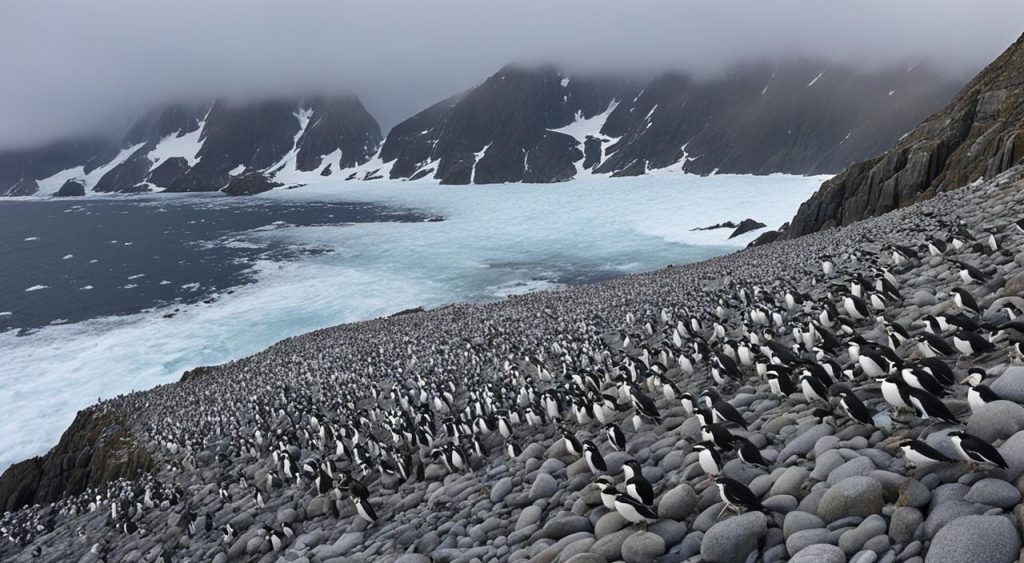
The Fascinating Behavior of Chinstrap Penguins
Chinstrap penguins are the charming seabirds of Antarctica. They have behaviors that fascinate researchers and wildlife fans. These flightless birds are known for their unique black “chinstrap” markings. They have social interactions and adaptations that help them survive in the tough Antarctic environment.
One key behavior of chinstrap penguins is their courtship rituals. In the breeding season, they perform a captivating display. They bill their beaks together and make sounds to strengthen their pair bonds. They also work together to build their nests by exchanging nesting materials like stones and twigs.
Chinstrap penguins are very adaptable to the Antarctic’s tough conditions. They huddle together to keep warm, which helps them survive the cold. They also plan their diving and hunting to make the most of their food.
| Behavior | Description |
|---|---|
| Courtship Rituals | Chinstrap penguins engage in billing, vocalizations, and the exchange of nesting materials to establish and maintain pair bonds. |
| Thermoregulation | They huddle together in groups to conserve body heat and withstand the harsh Antarctic temperatures. |
| Foraging Coordination | Chinstrap penguins coordinate their diving and foraging activities to maximize their chances of finding food. |
These behaviors, along with their charming looks, make chinstrap penguins fascinating seabirds of Antarctica.
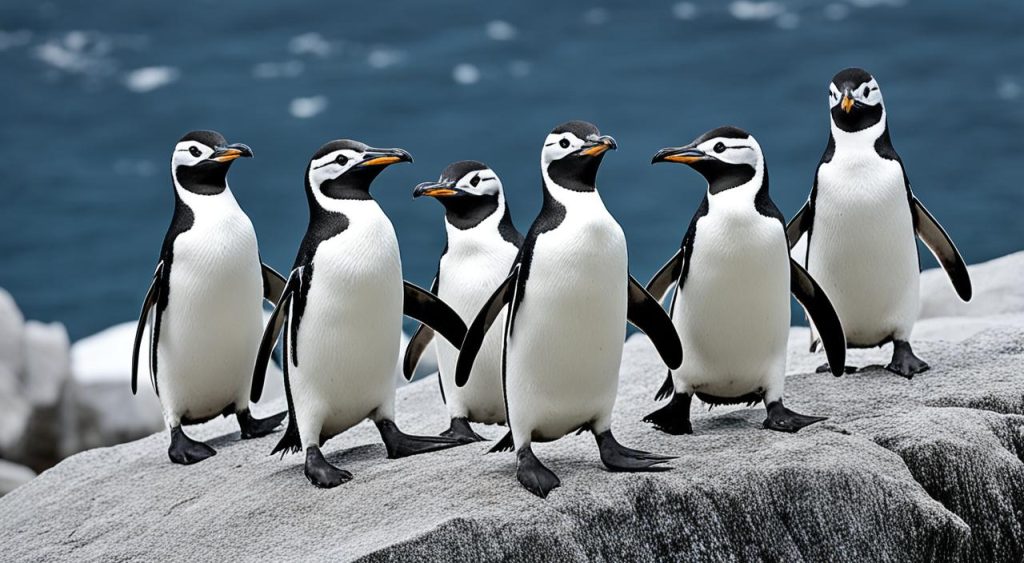
“Chinstrap penguins are a true marvel of evolution, showcasing their resilience and adaptability in the face of the Antarctic’s harsh conditions.”
Chinstrap Penguin Diet and Feeding Habits
The chinstrap penguin is a key seabird in the Antarctic ecosystem. It has a varied and flexible diet. These birds mainly eat krill, squid, and small fish in the icy waters around the Antarctic Peninsula.
Krill, Squid, and Fish: The Staples of Their Diet
Chinstrap penguins are skilled at finding food, diving hundreds of times a day. 95% of their diet is krill, a small shrimp-like crustacean. This food gives them the energy they need to stay active and feed their chicks during breeding season.
They also eat squid and small fish. These birds use different hunting methods to get enough food. They chase and herd their prey and use the natural behavior of their food sources to their advantage.
Adult chinstrap penguins weigh between 3.5 to 5.5 kg. They hunt in the ocean, usually less than 40 meters deep. With a life span of up to 20 years, they are important to the Antarctic marine food web.
Conservation Efforts for Chinstrap Penguins
Chinstrap penguins have a big population, but they face big challenges. Climate change and overfishing hurt their Antarctic home. Warming temperatures and sea ice changes mess with their homes and food. This can really hurt their numbers.
People are working hard to help them. This includes watching their numbers, making fishing sustainable, and protecting their homes. The IUCN says they’re not in danger yet, but their future is unsure. Human actions are putting a lot of pressure on their home.
| Chinstrap Penguin Conservation Statistics | Value |
|---|---|
| Breeding Pairs | Approximately 4 million |
| Adult Weight | 3.5 to 5.5 kilograms (7.7 to 12 pounds) |
| IUCN Conservation Status | Least Concern |
| Antarctic Tourism (2013-14 season) | Over 37,000 visitors |
| Key Management Authority | Commission for the Conservation of Antarctic Marine Living Resources (CCAMLR) |
The CCAMLR, made up of 24 countries and the EU, can make big marine reserves in the Southern Ocean. These reserves protect the Antarctic and its creatures, like the chinstrap penguins. By managing things sustainably and protecting their food, we can help these penguins thrive.
Chinstrap Penguin: Antarctica’s Dapper Seabird
The chinstrap penguin is a beloved species from Antarctica, known for its tuxedo-like look and charming ways. These seabirds have won over explorers, scientists, and nature lovers. They are loved for their unique waddle, jaunty eyebrows, and how they adapt to the harsh Antarctic climate.
As one of the most common penguins in the Southern Ocean, the chinstrap penguin is vital to the Antarctic ecosystem. They symbolize the region’s unique and precious wildlife. With their sleek black and white feathers, they look elegant as they move around.
Seeing a group of chinstrap penguins together on a snowy hillside shows their unique nature. The white snow and their black bodies make a beautiful scene. This highlights the beauty and strength of these tuxedo-clad penguins from Antarctica.
| Product | Starting Price |
|---|---|
| Canvas Prints | $79.99 |
| Jigsaw Puzzles | $79.99 |
| Poster Prints | $79.99 |
| Metal Prints | $169.99 |
There are many products featuring chinstrap penguins, like Canvas Prints, Jigsaw Puzzles, and Metal Prints. These items let fans decorate their spaces with these iconic seabirds. The professional quality and careful packaging of these gifts mean people can enjoy these images in their homes and offices worldwide.
“The chinstrap penguin is the epitome of Antarctic elegance, a true ambassador for the icy wilderness that it calls home.”
Witnessing the Wonders of Chinstrap Penguins on an Antarctic Expedition
Going on an Antarctic expedition lets you see chinstrap penguins in their home. These seabirds are known for their unique look and live in the tough Antarctic environment. You can watch them in large groups, see where they breed, and learn about their social life. This helps us understand why we must protect these amazing birds and their home.
Expeditions like those from Aurora Expeditions take you to Antarctica’s remote spots. You can see the biggest chinstrap penguin colony on Zavodovski Island. These trips last from 12 to 21 days and have discounts of up to 25% for some trips. Seeing the penguins and their amazing survival skills in this tough place is an experience you won’t forget.
On these trips, you can see how chinstrap penguins move and act. An Antarctic expedition is a chance to connect with nature’s wonders. You’ll visit places like Orne Harbor and Half Moon Island, seeing the delicate balance of the Antarctic ecosystem. It shows how important it is to visit responsibly and protect these seabirds for the future.
FAQ
What is a chinstrap penguin?
The chinstrap penguin, known scientifically as Pygoscelis antarcticus, lives in the Southern Ocean, mainly around the Antarctic Peninsula. They are famous for their black band under the chin, making them look like they’re wearing a tuxedo.
How many chinstrap penguins are there?
There are about 8 million chinstrap penguins, making them one of the most common penguin species in Antarctica.
Where is the largest chinstrap penguin colony located?
The biggest chinstrap penguin colony is on Zavodovski Island, part of the South Sandwich Islands in the Southern Ocean. This island is a volcanic island and is home to around 2 million breeding pairs of chinstrap penguins.
What are the physical features of chinstrap penguins?
Chinstrap penguins are loved for their cute waddling and unique eyebrows. They have sleek black and white feathers with a black band under their chin, looking like a tuxedo. This is why they are called “tuxedo birds”.
What are the nesting and breeding habits of chinstrap penguins?
They like to nest on rocky, ice-free areas, often on cliffs or flat spots near the ocean. Being one of the few penguin species that can live in areas with little snow and ice, they thrive in the Antarctic Peninsula.
What is the diet of chinstrap penguins?
They eat krill, squid, and small fish because they are opportunistic feeders. They dive many times a day to find food. This helps them support their chicks during the breeding season.
What are the conservation challenges for chinstrap penguins?
Chinstrap penguins face challenges like climate change and overfishing in their Antarctic home. Warmer temperatures and changes in sea ice affect their breeding and feeding spots. Losing their main food, krill, also impacts their numbers.
How can I witness the wonders of chinstrap penguins in their natural habitat?
To see chinstrap penguins in their natural setting, go on Antarctic expedition cruises. These trips let you see their colonies and watch their social life up close.
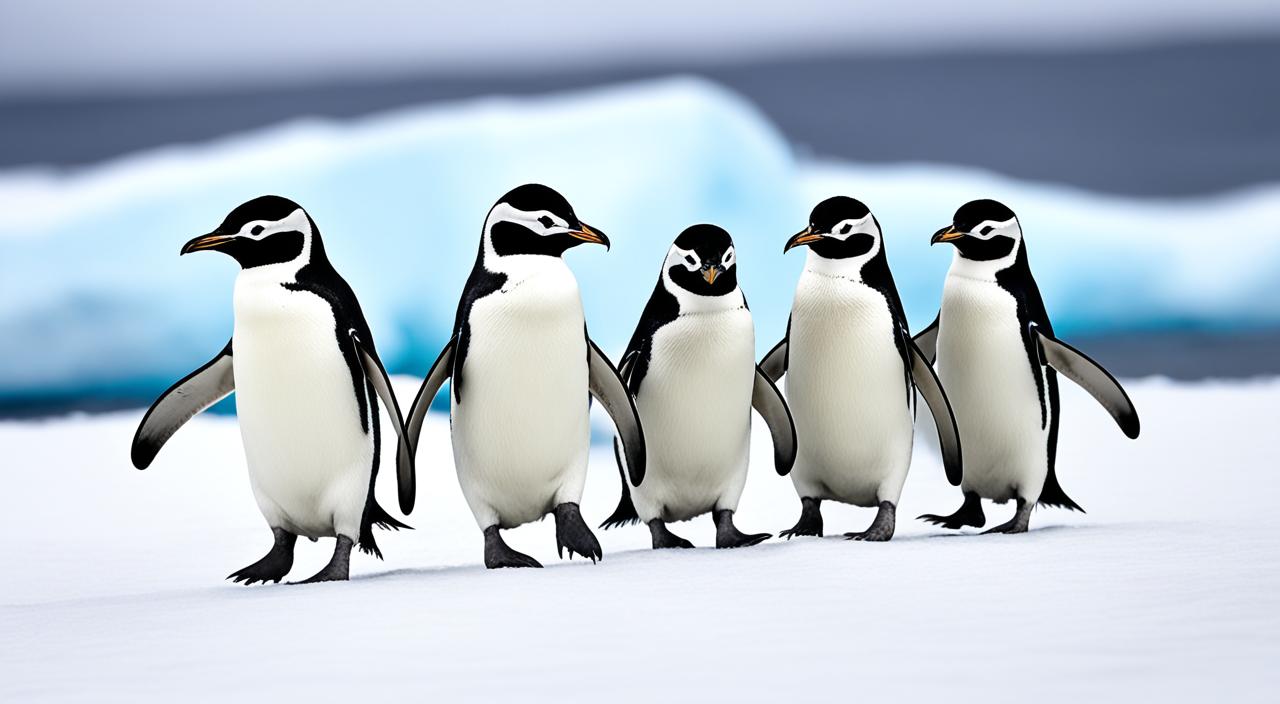


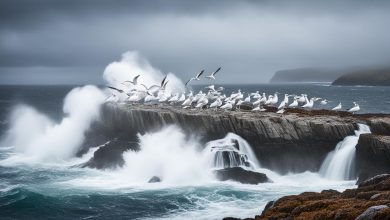
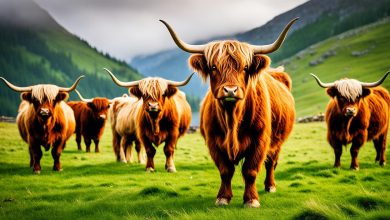
One Comment